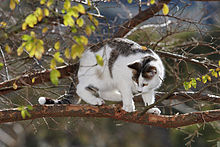High-rise syndrome

High-rise syndrome is the phenomenon of cats falling from higher than two stories (7–9 m / 24–30 ft). This is generally from high-rise buildings, or skyscrapers, and is also used to refer to the injuries sustained by a cat falling from high up.
Injuries sustained by cats falling
[edit]Studies done on cats that have fallen from 2 to 32 stories, and still alive when brought to a veterinarian clinic, show that the overall survival rate is 90 percent of those treated. [unreliable source?] [1] In a study performed in 1987 it was reported that cats who fall from less than six stories, and are still alive, have greater injuries than cats who fall from higher than six stories.[2][3] It has been proposed that this might happen because cats reach terminal velocity after righting themselves (see below) at about five stories, and after this point they relax, leading to less severe injuries in cats who have fallen from six or more stories.[4] Another possible explanation for this phenomenon would be the fact that cats who die in falls are less likely to be brought to a veterinarian than injured cats, and thus many of the cats killed in falls from higher buildings are not reported in studies of the subject.[1] However, the study was specifically about the extent of injuries (among the cats who survived long enough to be brought to the veterinarian).
In a more recent study it has been observed that cats falling from higher places would suffer more severe injuries.[5]
Righting
[edit]During a fall from a high place, a cat can reflexively twist its body and right itself using its acute sense of balance and flexibility.[6] This is known as the cat's "righting reflex". The minimum height required for this to occur in most cats (safely) would be around 90 centimetres (3 ft). To achieve this, cats probably relax their ventral muscles, "flattening" their bodies to some extent and creating more resistance to air.
However, it has been argued that, after having reached terminal velocity, cats would orient their limbs horizontally such that their body hits the ground first.[5] A 1987 study speculated that this is done after falling five stories to ensure the cat reaches a terminal velocity by thereafter relaxing and spreading their bodies to increase drag.[1][7]
Why cats fall from high places
[edit]Cats have a natural fondness for heights, but they do not often fall, because they are aware of their surroundings.[citation needed] However, if a cat is distracted by a potential prey, or if it falls asleep, it can fall. If this were to occur in a tree, for example, the cat would often be able to save itself by grabbing on with its claws. Many building materials such as concrete and painted metal, however, do not allow a cat to grip successfully.[8]
References
[edit]- ^ a b c "Do cats always land unharmed on their feet, no matter how far they fall?". The Straight Dope. July 19, 1996. Retrieved 2008-03-13.
- ^ Whitney, WO; Mehlhaff, CJ (1987). "High-rise syndrome in cats". Journal of the American Veterinary Medical Association. 191 (11): 1399–403. PMID 3692980.
- ^ Highrise Syndrome in Cats
- ^ Falling Cats
- ^ a b Vnuk, D; Pirkić, B; Maticić, D; Radisić, B; Stejskal, M; Babić, T; Kreszinger, M; Lemo, N (2004). "Feline high-rise syndrome: 119 cases (1998-2001)". Journal of feline medicine and surgery. 6 (5): 305–12. doi:10.1016/j.jfms.2003.07.001. PMID 15363762.
- ^ "Falling Cats". Retrieved 2005-10-24.
- ^ a 1987 study published in the Journal of the American Veterinary Medical Association of 132 cats that were brought into the New York Animal Medical Center after having fallen from buildings.
- ^ ASPCA warning on high-rise syndrome
